- Home
- Bill Bryson
The Road to Little Dribbling Page 14
The Road to Little Dribbling Read online
Page 14
When he was not hurling his money into foolish business ventures, Keiller devoted himself to ‘exploring the range of sexual practices’, as the Dictionary of National Biography delicately puts it. According to his biographer Lynda J. Murray, Keiller bemused a young woman named Antonia White by asking her to climb into a laundry basket ‘wearing nothing but a mackintosh so that he could poke her through the wicker work with an umbrella’. Quite how Keiller found pleasure in this and whether Ms White complied are questions not addressed in Murray’s otherwise thorough biography. With some like-minded men, he founded a club whose members took turns having sex with a willing (and presumably resilient) prostitute, then sat with whiskies and compared notes on the experience. Despite (or, for all I know, because of) these quirks, Keiller enjoyed a steady string of mistresses and four marriages.
In 1924, aged thirty-five, Keiller visited Avebury for the first time and instantly found a new calling. Avebury at that time was not the glorious, manicured treasure we find today. The stones, Murray relates, stood amid ‘a jumble of pigsties, derelict corrugated buildings, crumbling cottages, and an old garage which was in need of renovation. The whole area was overgrown with shrubs and trees and the remaining stones of the circle were overshadowed by indiscriminate building.’ Many stones were toppled. Others had been broken up in earlier times and used as building materials. When Keiller arrived just fifteen stones were still standing.
Keiller bought Avebury Manor and invested his wealth and considerable energies in a far-sighted programme of excavation and restoration. He wasn’t universally popular in the village because of his inclination to tear down cottages and barns that interfered with his excavations and because he booted some elderly tenants out of an estate cottage so that he could park a mistress there. But there is no question that the archaeological work he funded was world class and made Avebury what it is today. Keiller spent nearly twenty years excavating until in 1943, his health failing, he sold out to the National Trust. He died the following decade, pretty well forgotten.
I was particularly keen to see the manor house as I assumed it would be filled with Keiller’s personal curios and archaeological treasures. But no. In what must be the cheesiest thing the National Trust has ever done, it had allowed the house to be made into a set for a now-forgotten BBC television series. The idea of the series was to decorate each room in the style of a different period, reflecting the ages through which the house has stood. It probably sounded like an excellent notion on paper. The problem is that it was clearly executed by designers and crews who build sets for a living. If you ever go to a television studio the thing that most immediately strikes you is how slapdash it all is. Props and furnishings that look perfectly all right on screen are, up close, patently fake. I was once on the set of University Challenge. From the front it looks fine, but step behind and you see that it is really just a lot of plywood and duct tape.
Each room of the manor house looked like it was done in about twenty minutes. Just one small room was devoted to the period of Keiller’s residency, and it told you almost nothing about why he came to Avebury and what he achieved there. The other rooms had nothing whatever to do with the monuments outside.
The accompanying museum, in a nearby stable block, was only fractionally less disappointing. Avebury is a World Heritage Site for a reason. It is an astonishing, fascinating place, yet the museum seemed perfunctory and uninspired, as if it were fulfilling an obligation rather than reflecting an enthusiasm. We know almost nothing about the people who built Avebury – their language, culture, beliefs, pastimes, where they came from, even what kind of clothing they wore. They are a complete mystery. Yet they had the ambition and organizational skill to build the greatest stone circle in Europe. But any sense of wonder this instills must be supplied by the visitors themselves.
Of these there were plenty, I must say. I was surprised at how popular Avebury has become. By eleven in the morning, the crowds were pretty thick. I had to queue to get through a kissing gate and was very glad I had had my cup of tea already because there was quite a line at the café now as well.
Just over a mile from Avebury is something about as amazing and possibly even more memorable than Avebury itself: Silbury Hill. This is not a National Trust property, so the Trust doesn’t draw visitors’ attention to it. That is unfortunate, for Silbury Hill is a wonder. It is 130 feet high – about the height of a ten-storey building – and is entirely made by hand. It is the tallest artificial prehistoric mound in the world. There is nothing like it anywhere else. It is covered in grass and is uniform all the way round. It is sensationally lovely to look at. It is genuinely perfect. It deserves to be world famous.
Silbury Hill is easily reached from Avebury across some fields. The walk was very pleasant, but the path was largely overgrown and clearly not much used. I had to push my way through a lot of nettles and brambles. I didn’t see another soul. You can’t walk up Silbury Hill – it is too fragile – but you can stand and stare at it for as long as you like. I could have stayed for most of the day, I think – it is that arresting. Its construction involved an almost unimaginable amount of labour, yet it has no known purpose. It is not a burial mound. It holds no treasures. It is nothing but soil and rock painstakingly formed into a large pudding-shaped hill. All that can be said for certain is that at some point in the massively distant past, for reasons unknown, some people decided to make a hill where none had stood before. Even where the material in the hill came from is a mystery. It is not as if there is a 130-foot hole nearby. The landscape is perfectly undisturbed, yet somehow and for some reason people were able to bring in enough soil and rock to build a small mountain. Extraordinary.
But that’s not all. Across a busy highway – one must waddle smartly, rucksack jiggling – and a quarter of a mile or so up a sloping track is the West Kennet Long Barrow, a large burial chamber. This, too, I had all to myself. The view from the top was extremely fine. In the foreground was Silbury Hill, shapely and majestic. In the middle distance, glinting in the sunshine, were a couple of hundred cars parked in the National Trust car park, with still more coming in all the time. All around in every direction were lovely low hills and rich-looking farmland.
The barrow itself, however, didn’t at first glance seem terribly thrilling. It is just a long, grassy mound that has settled so well into the landscape that it seems almost a natural feature. But looking around more closely, I discovered an entrance, semi-hidden behind a massive rock, and I crept in. The whole became immediately sensational. Here, I could see that the barrow was made from giant stones, many as big as anything at Avebury, lifted into position to form walls and ceilings. The barrow is three hundred feet long. This was an enormous undertaking. It was built 5,500 years ago, but as far as could be told fewer than fifty people were interred there in a period of only twenty-five years or so. The bodies were arranged by sex and age. More than that, no one will ever be able to say.
I was so glad that I had traipsed up here. I went and stood on the roof of the barrow again and surveyed the view, feeling like a conqueror, pleased to have it all to myself.
‘And this part of the day didn’t cost me a penny,’ I said proudly, hands on hips.
Chapter 10
To the West
I
ONE DAY IN the London Library I came across two books that changed my life, or at least the small part of it that is concerned with British highways.
The first was a slender work called Report of the Departmental Committee on Roads (1944), published by His Majesty’s Stationery Office, which addressed the issue of road numbering and how it might be improved after the war. I was captivated to think that while all the rest of the Allied world was training for D-Day, a parliamentary committee in Westminster was focused on the perhaps-not-quite-so-pressing issue of post-war road numbering. I imagined twenty men sitting around a table in some underground bunker, white plaster dust settling on to their heads and shoulders from the reverberations of German bombs falling
nearby, and the chairman saying: ‘And now to the matter of whether the B3601 should be upgraded to arterial status between Slumpton Dumpton and Great Twitching. Who would like to open the discussion?’
Beside the departmental committee report on the shelf was a plumper, more recent work called A, B, C and M: Road Numbering Revealed, by Andrew Emmerson and Peter Bancroft. This explained in exhaustive detail – and when I say exhaustive I am using the word with a rare degree of precision – the history and methodology of British road numbering.
I was surprised to learn that there is a system to British road numbering, but then I remembered that it is a British system, which means it is not like systems elsewhere. The first principle of a British system is that it should only appear systematic. That is the nub of it really. It is what sets British systems apart from those created by less idiosyncratic peoples. With respect to roads, it works like this: England is divided into six sectors defined by the A roads emanating from London. So you start at the top with the A1 (London to Edinburgh), then move in a clockwise fashion to the A2 (London to Dover), A3 (London to Portsmouth), and so on all the way round to the A6 (London to Carlisle). These six roads divide the country into wedge-shaped sectors (think of England as a badly made pizza). In principle, all the roads in each wedge are assigned the same initial digit, so that, for instance, the A11 and B1065 are both in sector 1 (i.e. between the A1 and A2), while the A30, A327 and B3006 are all in sector 3. In theory, therefore, if you wake from a coma and don’t know where you are, you have only to determine the number of the road you are on and if it starts with a 1, you know that you are somewhere between London and Edinburgh and to the east of the A1 but west of the A2, and can start to plan your life accordingly.
What makes the system enchanting to people like Emmerson and Bancroft is that it doesn’t actually work. It never could. That is, as I say, the brilliance of it. For one thing, roads must leave their assigned sectors in order to proceed across the country. The A38, for instance, starts in Zone 3, as it ought to, but trespasses into Zones 4, 5 and 6 as it travels from Devon to Nottinghamshire. The A41 actually starts and finishes in Zone 5. It’s called the A41 because – well, I don’t know why. The rule – I am not making this up; no one could – is that roads may venture into other zones and retain their number as long as their direction of travel is clockwise and not anticlockwise, though this rule has exceptions, too.
Another interesting quirk of the British system – and when I use the word ‘system’ in this chapter imagine me making bunny ears with my fingers each time – are the many roads that are non-continuous. The A34 runs from Winchester to Oxford, then disappears completely, only to rematerialize sixty miles up the road in Birmingham. The A46 similarly runs from Tewkesbury to Coventry, but then gives up the will to live (a feeling we have all had in Coventry, I daresay) before popping up again in Leicester and continuing on to Lincoln. (It may continue beyond Lincoln; no one has ever gone there to find out.) Uncovering these discontinuities, say Emmerson and Bancroft, is a reliable source of ‘harmless amusement’. I’ll say.
‘A fascinating pursuit,’ they go on, ‘is the search for missing junction numbers, such as Junction 3 of the M1 motorway.’ Indeed. How many times have we all wondered where the fuck that got to? The answer is that it was supposed to lead to a connection to the A1 that never got built. And to think there are people who need alcohol or sex to have fun.
All British systems are like this, I find. Just look at the English language, and the rules of spelling, grammar and punctuation. Who but the British would come up with spellings like ‘eight’ and ‘island’ that are obvious strangers to phonetics, or a word like ‘colonel’ which clearly has no r in it but is pronounced as if it did? Or look at the British constitution, which isn’t written down on a single piece of parchment headed ‘Constitution’, as you might expect, but is scattered all over the place in drawers and filing cabinets and no doubt in old trunks from which the key was lost in the time of Anne of Cleves. No one knows what is in the British constitution because it doesn’t actually exist except as a notion. Or look at the old money, with its florins and half crowns and thrupenny bits, and imagine what it was like in the days when people had to add tuppence ha’penny to one shilling four nibblings or whatever.
It is often suggested that the British do these things for the pleasure of confusing foreigners, but that is quite wrong. The British don’t give a shit about foreigners. They do it to confuse themselves. I can’t say why that is because the British won’t tell me. It is not something you can talk to them about because frankly they are in a bit of a state of denial over it. If you suggest to any British person that there is anything odd or irregular about any part of a British system – let’s say, just for the sake of argument, about weights and measures – they get instantly iffy and say, ‘I don’t know what you are talking about.’
‘But it’s full of meaningless units like bushels and firkins and kilderkins,’ you point out. ‘They make no sense.’
‘Of course they make sense,’ the British person will sniff. ‘Half a firkin is a jug, half a jug is a tot, half a tot is a titter, half a titter is a cock-droplet. What’s not logical about that?’
There really is no talking to them about it, so I don’t know why they do it, any more than I know why they watch Miranda in large numbers or think that jam makes a cake delicious. It’s just the way they are.
But having said that, I have come to appreciate with the passing years that there are certain virtues in being unsystematic. For one thing, it keeps you from being Swiss, and that is worth any price obviously. It also gives life a richness and unpredictability that endows even the simplest undertakings with an air of challenge and uncertainty.
Compare finding your way around London with finding your way around Paris. As everyone knows, Paris is divided into arrondissements. These are numbered sequentially in a clockwise fashion from the centre. Once you have spent ten minutes with a map of Paris, you will understand arrondissements for ever. London uses postal districts for organizing itself. These begin logically enough in the central area, with W1 beside W2 and WC1 beside WC2, but then it all unravels as you move outwards because outside central London the districts are numbered alphabetically after the names of postal sorting offices. That means that SW6 and SW18 stand side by side. N15 abuts N4 and N22. SE2 is twelve miles from SE1. (Moving east from SE1 you cross, in this order, SE16, SE8, SE10, SE7, SE18 and a corner of SE28.)
What all this means in practice is that the only way to understand the layout of London is to spend years studying it. If you haven’t done your homework and you try to travel from SE1 to E4, you could end up anywhere. There are people in London living in doorways or under railway bridges because they couldn’t find E4. They all made the mistake of assuming it was in East London, when in fact, as anyone who has studied a map knows, E4 is actually a northern zone. In fact, it is the northernmost of all London postal zones. That is, of course, why it is called E4.
The downside in all this is that you can easily cross a line and become too interested in road numbering or London postal districts or almost anything, and the next thing you know you have joined a society and receive a quarterly newsletter, possibly even pay money to go on coach trips. This is the point at which you should seek medical help.
Anyway, I can’t pretend to really understand British systems, but I can tell you that on the fine spring morning when our story resumes I made my way west through Hampshire and Dorset principally along the B3006, A31 and A354 but with an interesting discontinuity on the A3090 between Hockley Viaduct and Oliver’s Battery, and, after taking advice in a petrol station as to the best route between Romsey and Blandford Forum, reached Lyme Regis in late morning.
I have a great fondness for Lyme Regis, based almost exclusively on a hotel my wife and I stayed at there many years ago over a wintry weekend as an extravagant treat when we were young and poor. It was a small hotel on the clifftop with long views across a cold sea. I think i
t had once been a private home, and it had seen better days, but to us it was the height of elegance because it had its own bar and there was a sweets trolley at dinner. When the sweets trolley came rattling out each evening, laden with rich treasures, every head in the dining room craned eagerly, believe me. The hotel was run by one harried, irritable man who seemed to be engaged in a long-term battle with the hotel infrastructure. I remember ordering a pint of lager in the tiny bar, and for the next ten minutes watched as he held a glass to a spigot that coughed and sputtered while he waggled the handle impatiently. At length he presented me with a glass about three-quarters filled with what seemed to be warm shaving foam. ‘I’ll have to change the barrel,’ he muttered unhappily, as if I were being unreasonable with respect to beverages, and disappeared through a door. We never saw him in the bar again.
Lyme Regis remains a fine town, with a very steep high street, called Broad Street, leading up from Lyme Bay to a feast of wooded hills, which formerly were made up exclusively of large Victorian houses, but now seem also to incorporate a great many municipal car parks. Lyme clearly struggles to accommodate the number of people who wish to drive through its narrow streets and leave their cars to sun while they shuffle around looking for refreshments and knick-knacks. For a while, the principal gift shop item in Britain seemed to be mugs, tea towels and other kitchen items that said ‘Keep Calm and Carry On’ on them, but now the thing seems to be to have planks of wood bearing inspirational messages like:

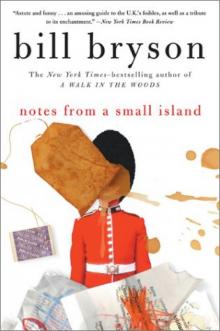 Notes from a Small Island
Notes from a Small Island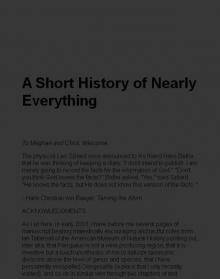 A Short History of Nearly Everything
A Short History of Nearly Everything A Walk in the Woods
A Walk in the Woods I'm a Stranger Here Myself
I'm a Stranger Here Myself The Mother Tongue
The Mother Tongue Shakespeare
Shakespeare A Short History of Nearly Everything: Special Illustrated Edition
A Short History of Nearly Everything: Special Illustrated Edition The Best American Travel Writing 2016
The Best American Travel Writing 2016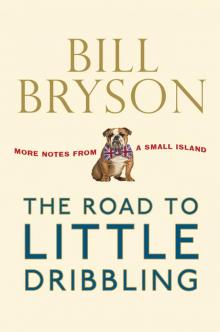 The Road to Little Dribbling
The Road to Little Dribbling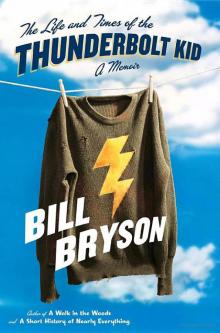 The Life And Times Of The Thunderbolt Kid: A Memoir (v5.0)
The Life And Times Of The Thunderbolt Kid: A Memoir (v5.0) Made In America
Made In America Seeing Further
Seeing Further Shakespeare: The World as Stage
Shakespeare: The World as Stage The Life and Times of the Thunderbolt Kid
The Life and Times of the Thunderbolt Kid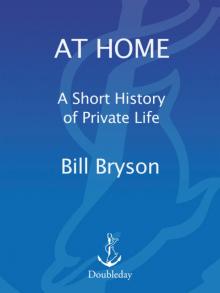 At Home
At Home Bryson's Dictionary For Writers And Editors (v5.0)
Bryson's Dictionary For Writers And Editors (v5.0) Neither Here Nor There
Neither Here Nor There Bill Bryson's African Diary
Bill Bryson's African Diary